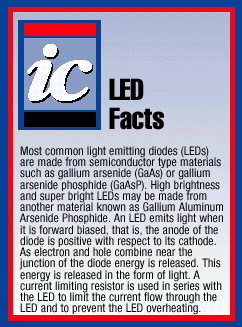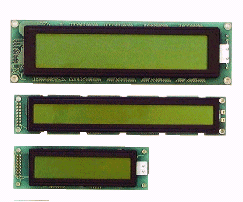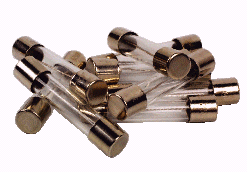|
set entirely by the feedback network.
They are widely used when a closely controlled amount of gain or
some form of signal processing is necessary in an electronic
system.

The branch of electronics dealing with
devices that generate, transform, transmit, or sense optical,
infrared, or ultraviolet radiation, as cathode-ray tubes,
electroluminescent and liquid crystal displays, lasers and solar
cells.

A light-emitting diode is a semiconductor
diode that converts electrical energy into light when an
alternating current is applied.
Note: This does not apply to flashing LEDs.
Flashing LEDs can be driven from a voltage source, i.e. without a
resistor


A liquid crystal display is a screen in
which a liquid crystal material

sandwiched between two sheets of glass
exhibits computer data when a voltage appears across leads that
are connected to character-forming segments etched onto its inner
glass surface.

An optocoupler, also known as an
optoisolator, is a semiconductor device that allows signals to be
transferred between circuits or systems, while keeping those
circuits or systems electrically isolated from each other.
|
|
|

Fuses provide reliable and low cost
protection against excessive currents, which occur during
overloads. There are many different types and styles of fuses and
selecting a fuse for a particular application can be difficult.
When replacing a blown fuse, try to obtain
a fuse with a rating as close as possible to the original. If it
is not possible to locate an exact replacement, remember this a
higher current fuse will offer less protection to the equipment,
increas-ing the risk of dam-age and fire. A lower current fuse
will offer more protection, but will be more prone to nuisance
blowing. Therefore, it is better to substitute a lower value fuse
until the correct type is obtained.

This indicates the current carrying
capacity of a fuse under a particular set of test conditions, at
25 o C. Fuses operated at a higher temperature need to be de-rated
and allowance must be made for any surge that occurs during
switch-on. It is generally recommended that fuses be specified at
125% of normal load current in order to avoid nuisance blowing.

This is the maximum circuit voltage at
which a fuse can be relied upon to safely interrupt an
over-current. At voltages higher than the rating, a fuse may not
be able to suppress the internal arcing that occurs after the fuse
link melts. In electronic circuits, where limiting impedances
ensure that the fault current is kept low so that a destructive
arc cannot occur, fuses may sometimes be used beyond their
specified voltage rating.

Standard fast acting fuses are designed to
open very quickly during an overload. They are not designed to
withstand the inrush current or switch-on surge that occurs in
some equipment.
Time delay or slow blow fuses are designed
to tolerate the temporary overloads that occur during switch-on,
but they still blow quickly if subjected to gross overloads during
faults. Slow blow fuses are commonly used in the primary circuits
of electronic equipment, where the initial surge can be many times
the normal load current. Slow blow fuses and fast acting fuses are
not interchangeable due to their different time characteristics.

It should be understood that the overload
needed to cause even a fast acting fuse to open quickly must be of
the order of 200% or more. An overload of only 35% (ie. a 4A
through 3A fuse) could take an hour to open a fuse. |
|
![]()